Business Decision Making Report: Investment & Tesco Analysis
VerifiedAdded on 2022/12/28
|11
|3046
|155
Report
AI Summary
This report, prepared for the Business Decision Making course, provides a comprehensive analysis of investment appraisal techniques used in business decision-making. It begins by evaluating two machine models, Duke and Earl, using payback period, accounting rate of return, net present value, and internal rate of return. The analysis includes detailed calculations and a comparative report for senior management, recommending the optimal investment choice. The report then shifts focus to Tesco Plc, assessing its financial structure from 2017 to 2019, evaluating key financial ratios, discussing the limitations of accounting ratios, and identifying factors affecting Tesco's performance. The report concludes with a summary of findings and recommendations, offering insights into financial decision-making and corporate performance evaluation.
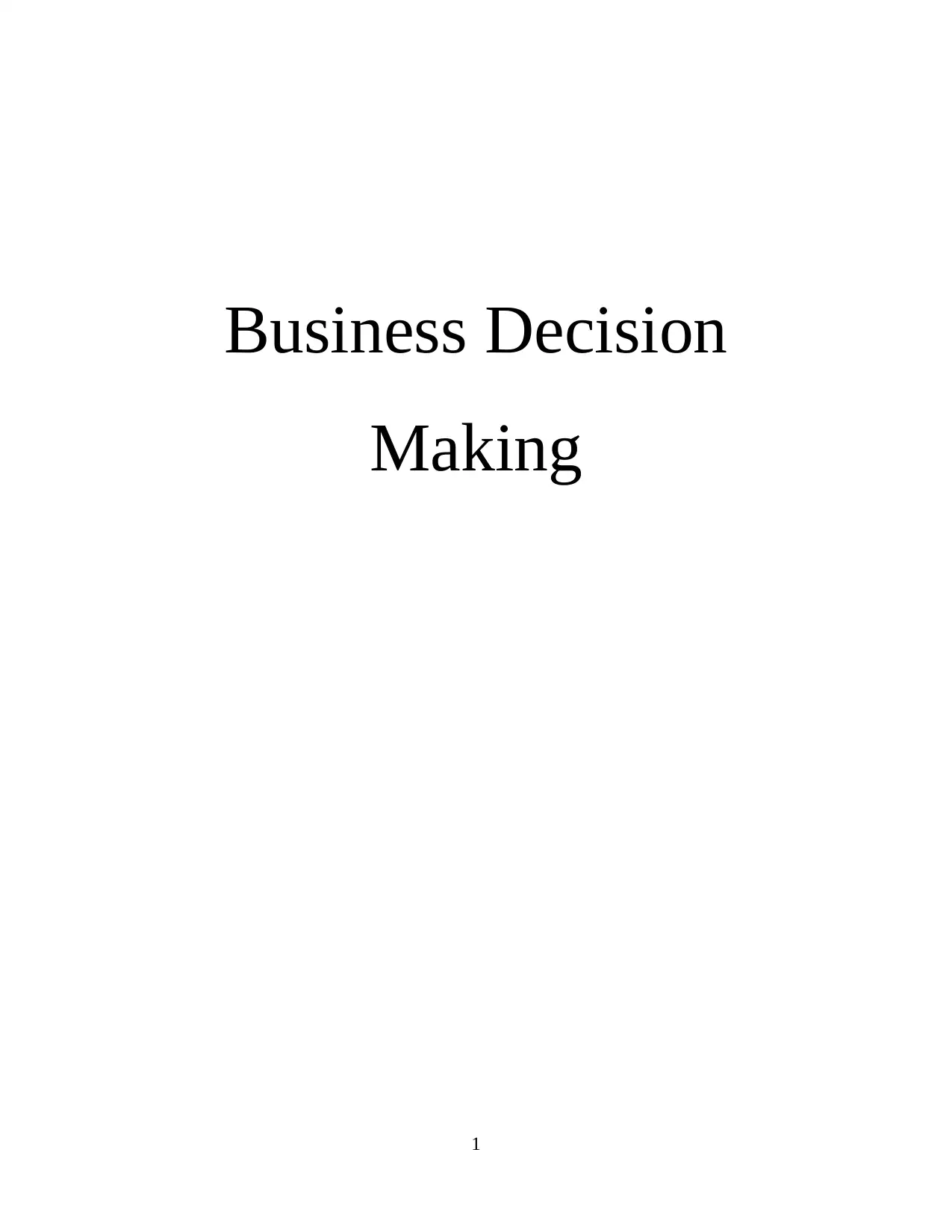
Business Decision
Making
1
Making
1
Paraphrase This Document
Need a fresh take? Get an instant paraphrase of this document with our AI Paraphraser
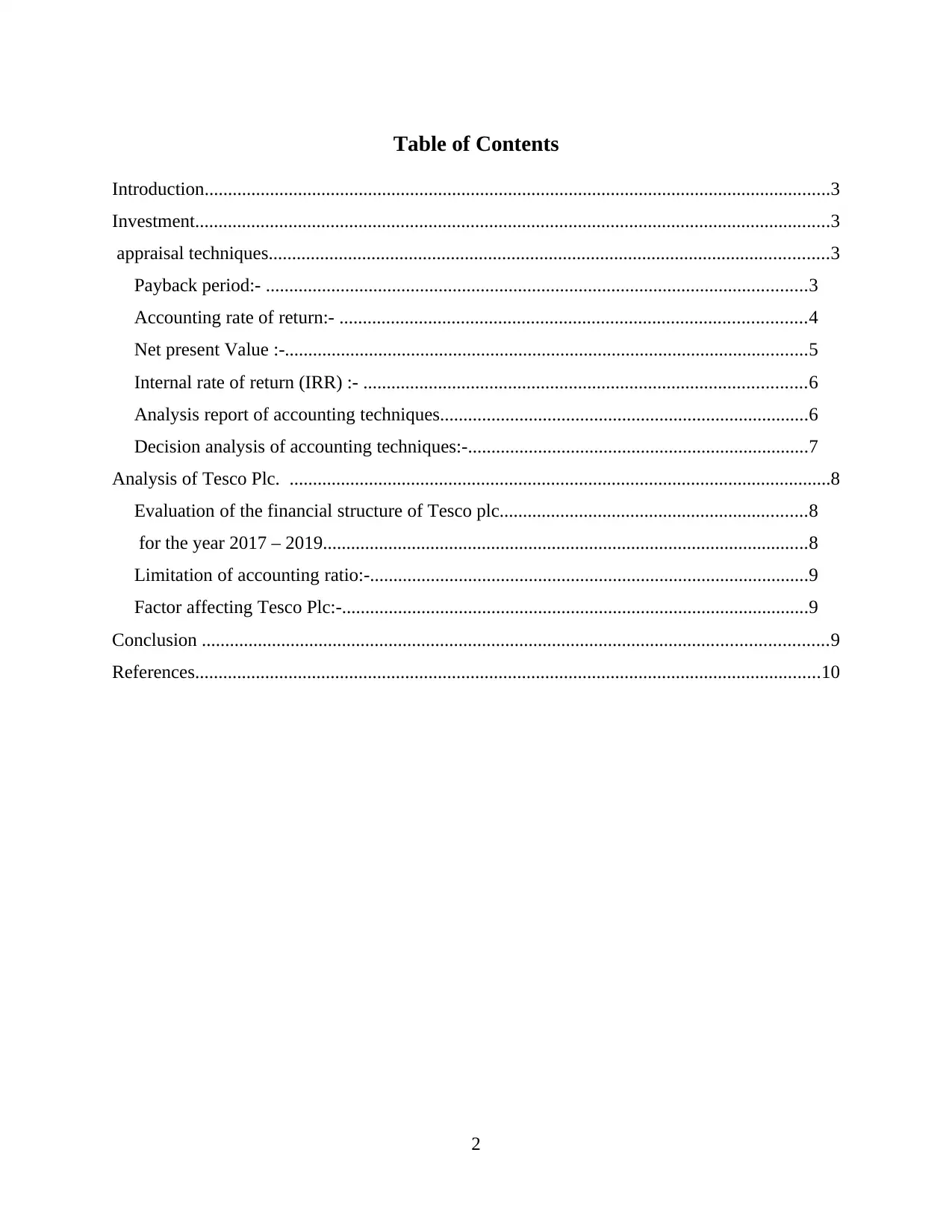
Table of Contents
Introduction......................................................................................................................................3
Investment........................................................................................................................................3
appraisal techniques........................................................................................................................3
Payback period:- ....................................................................................................................3
Accounting rate of return:- ....................................................................................................4
Net present Value :-................................................................................................................5
Internal rate of return (IRR) :- ...............................................................................................6
Analysis report of accounting techniques...............................................................................6
Decision analysis of accounting techniques:-.........................................................................7
Analysis of Tesco Plc. ....................................................................................................................8
Evaluation of the financial structure of Tesco plc..................................................................8
for the year 2017 – 2019........................................................................................................8
Limitation of accounting ratio:-..............................................................................................9
Factor affecting Tesco Plc:-....................................................................................................9
Conclusion ......................................................................................................................................9
References......................................................................................................................................10
2
Introduction......................................................................................................................................3
Investment........................................................................................................................................3
appraisal techniques........................................................................................................................3
Payback period:- ....................................................................................................................3
Accounting rate of return:- ....................................................................................................4
Net present Value :-................................................................................................................5
Internal rate of return (IRR) :- ...............................................................................................6
Analysis report of accounting techniques...............................................................................6
Decision analysis of accounting techniques:-.........................................................................7
Analysis of Tesco Plc. ....................................................................................................................8
Evaluation of the financial structure of Tesco plc..................................................................8
for the year 2017 – 2019........................................................................................................8
Limitation of accounting ratio:-..............................................................................................9
Factor affecting Tesco Plc:-....................................................................................................9
Conclusion ......................................................................................................................................9
References......................................................................................................................................10
2
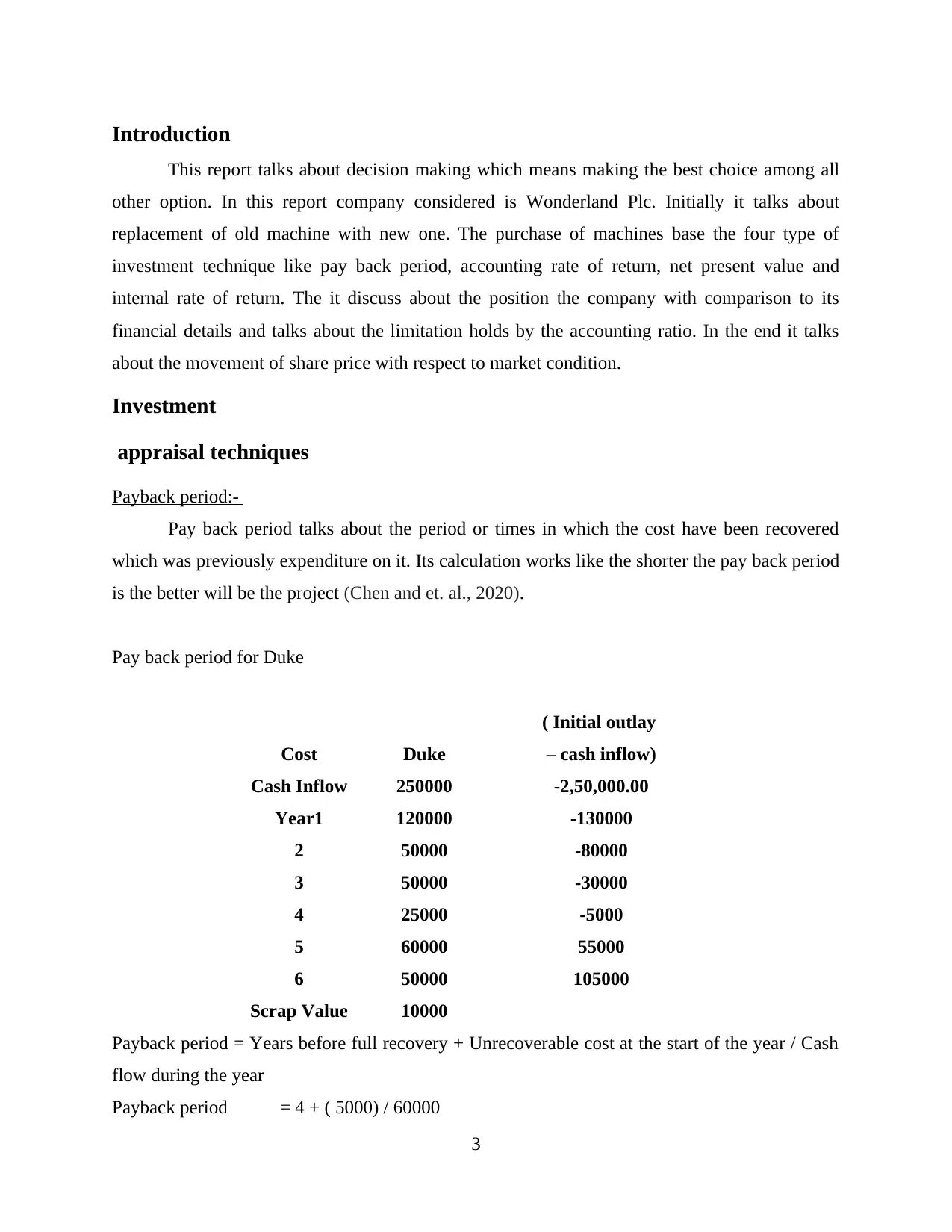
Introduction
This report talks about decision making which means making the best choice among all
other option. In this report company considered is Wonderland Plc. Initially it talks about
replacement of old machine with new one. The purchase of machines base the four type of
investment technique like pay back period, accounting rate of return, net present value and
internal rate of return. The it discuss about the position the company with comparison to its
financial details and talks about the limitation holds by the accounting ratio. In the end it talks
about the movement of share price with respect to market condition.
Investment
appraisal techniques
Payback period:-
Pay back period talks about the period or times in which the cost have been recovered
which was previously expenditure on it. Its calculation works like the shorter the pay back period
is the better will be the project (Chen and et. al., 2020).
Pay back period for Duke
Cost Duke
( Initial outlay
– cash inflow)
Cash Inflow 250000 -2,50,000.00
Year1 120000 -130000
2 50000 -80000
3 50000 -30000
4 25000 -5000
5 60000 55000
6 50000 105000
Scrap Value 10000
Payback period = Years before full recovery + Unrecoverable cost at the start of the year / Cash
flow during the year
Payback period = 4 + ( 5000) / 60000
3
This report talks about decision making which means making the best choice among all
other option. In this report company considered is Wonderland Plc. Initially it talks about
replacement of old machine with new one. The purchase of machines base the four type of
investment technique like pay back period, accounting rate of return, net present value and
internal rate of return. The it discuss about the position the company with comparison to its
financial details and talks about the limitation holds by the accounting ratio. In the end it talks
about the movement of share price with respect to market condition.
Investment
appraisal techniques
Payback period:-
Pay back period talks about the period or times in which the cost have been recovered
which was previously expenditure on it. Its calculation works like the shorter the pay back period
is the better will be the project (Chen and et. al., 2020).
Pay back period for Duke
Cost Duke
( Initial outlay
– cash inflow)
Cash Inflow 250000 -2,50,000.00
Year1 120000 -130000
2 50000 -80000
3 50000 -30000
4 25000 -5000
5 60000 55000
6 50000 105000
Scrap Value 10000
Payback period = Years before full recovery + Unrecoverable cost at the start of the year / Cash
flow during the year
Payback period = 4 + ( 5000) / 60000
3
⊘ This is a preview!⊘
Do you want full access?
Subscribe today to unlock all pages.

Trusted by 1+ million students worldwide
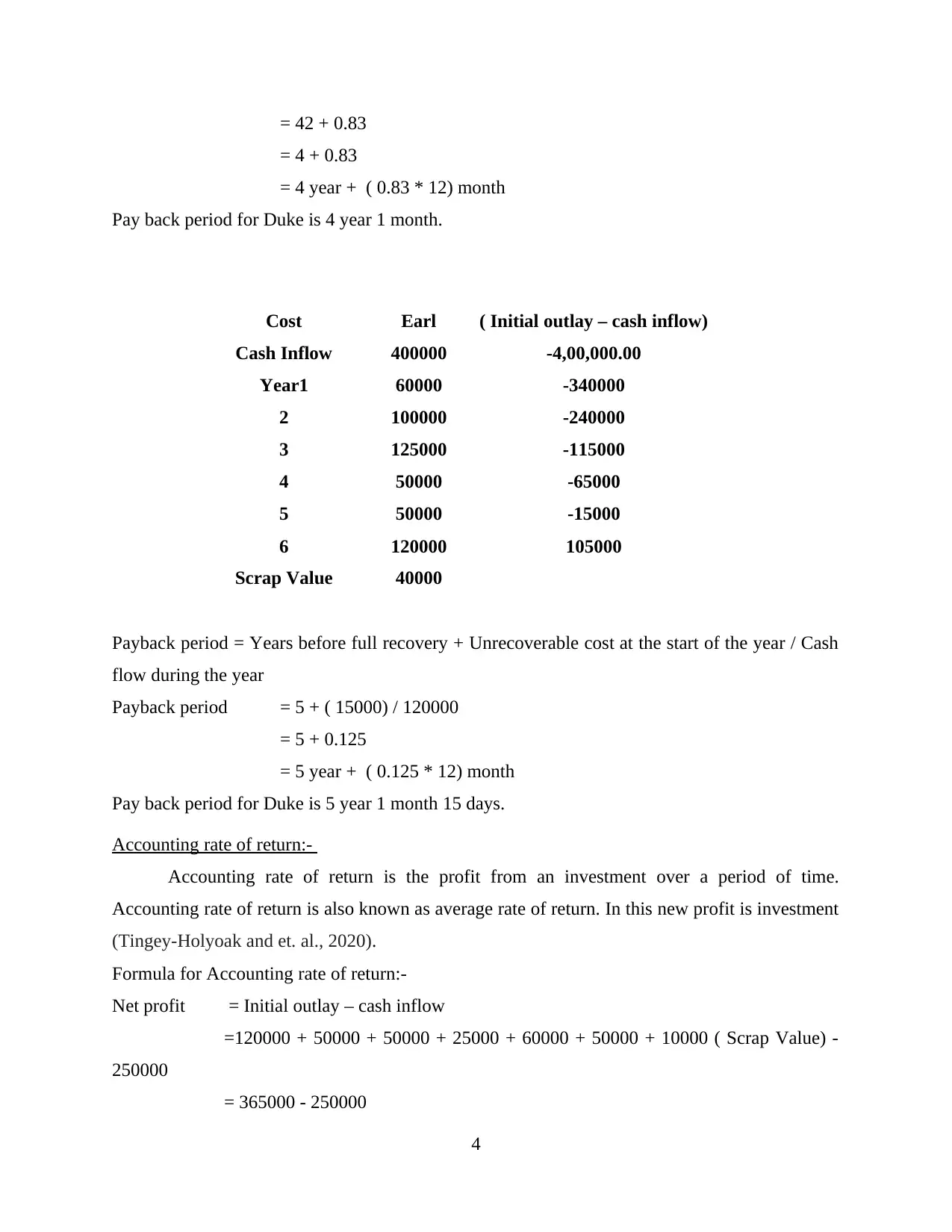
= 42 + 0.83
= 4 + 0.83
= 4 year + ( 0.83 * 12) month
Pay back period for Duke is 4 year 1 month.
Cost Earl ( Initial outlay – cash inflow)
Cash Inflow 400000 -4,00,000.00
Year1 60000 -340000
2 100000 -240000
3 125000 -115000
4 50000 -65000
5 50000 -15000
6 120000 105000
Scrap Value 40000
Payback period = Years before full recovery + Unrecoverable cost at the start of the year / Cash
flow during the year
Payback period = 5 + ( 15000) / 120000
= 5 + 0.125
= 5 year + ( 0.125 * 12) month
Pay back period for Duke is 5 year 1 month 15 days.
Accounting rate of return:-
Accounting rate of return is the profit from an investment over a period of time.
Accounting rate of return is also known as average rate of return. In this new profit is investment
(Tingey-Holyoak and et. al., 2020).
Formula for Accounting rate of return:-
Net profit = Initial outlay – cash inflow
=120000 + 50000 + 50000 + 25000 + 60000 + 50000 + 10000 ( Scrap Value) -
250000
= 365000 - 250000
4
= 4 + 0.83
= 4 year + ( 0.83 * 12) month
Pay back period for Duke is 4 year 1 month.
Cost Earl ( Initial outlay – cash inflow)
Cash Inflow 400000 -4,00,000.00
Year1 60000 -340000
2 100000 -240000
3 125000 -115000
4 50000 -65000
5 50000 -15000
6 120000 105000
Scrap Value 40000
Payback period = Years before full recovery + Unrecoverable cost at the start of the year / Cash
flow during the year
Payback period = 5 + ( 15000) / 120000
= 5 + 0.125
= 5 year + ( 0.125 * 12) month
Pay back period for Duke is 5 year 1 month 15 days.
Accounting rate of return:-
Accounting rate of return is the profit from an investment over a period of time.
Accounting rate of return is also known as average rate of return. In this new profit is investment
(Tingey-Holyoak and et. al., 2020).
Formula for Accounting rate of return:-
Net profit = Initial outlay – cash inflow
=120000 + 50000 + 50000 + 25000 + 60000 + 50000 + 10000 ( Scrap Value) -
250000
= 365000 - 250000
4
Paraphrase This Document
Need a fresh take? Get an instant paraphrase of this document with our AI Paraphraser
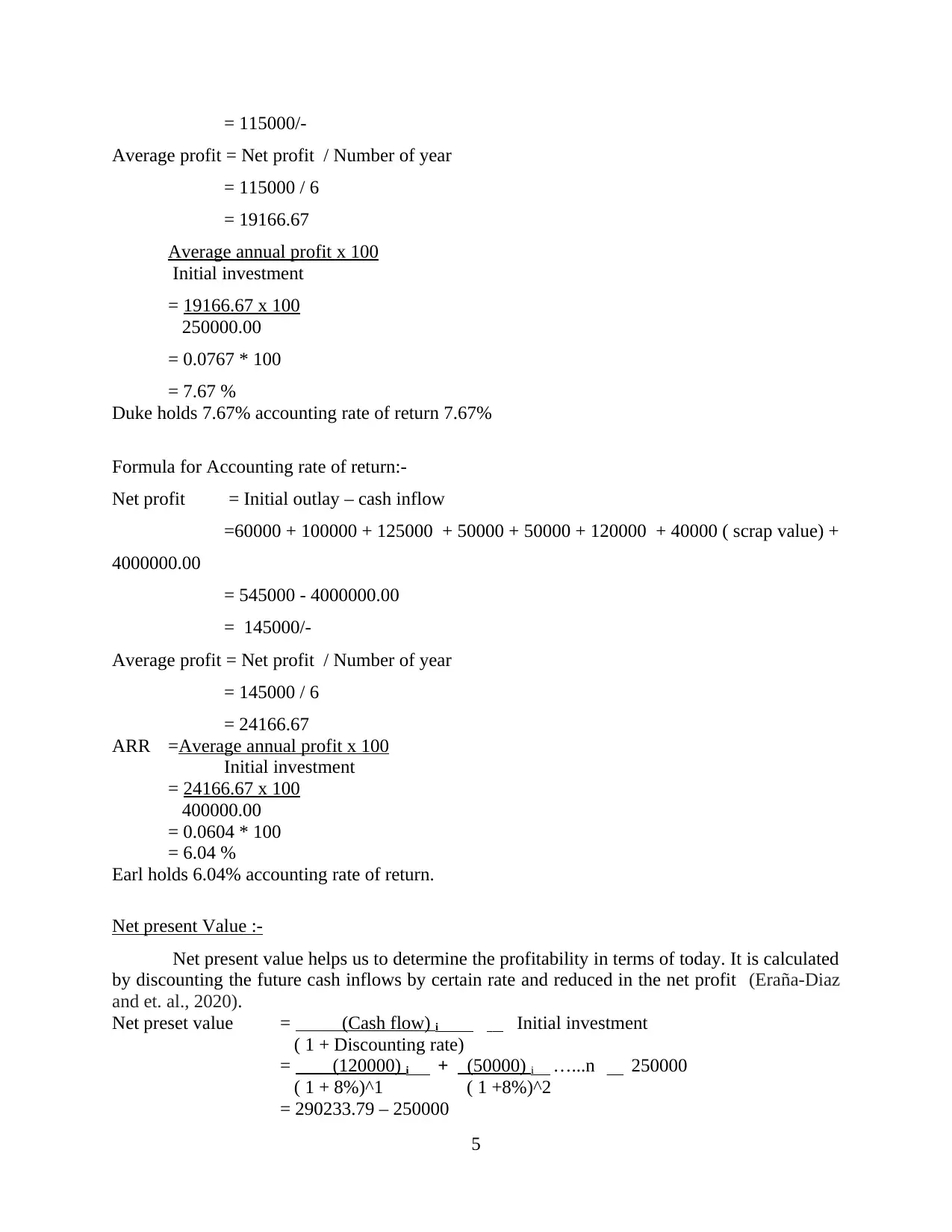
= 115000/-
Average profit = Net profit / Number of year
= 115000 / 6
= 19166.67
Average annual profit x 100
Initial investment
= 19166.67 x 100
250000.00
= 0.0767 * 100
= 7.67 %
Duke holds 7.67% accounting rate of return 7.67%
Formula for Accounting rate of return:-
Net profit = Initial outlay – cash inflow
=60000 + 100000 + 125000 + 50000 + 50000 + 120000 + 40000 ( scrap value) +
4000000.00
= 545000 - 4000000.00
= 145000/-
Average profit = Net profit / Number of year
= 145000 / 6
= 24166.67
ARR =Average annual profit x 100
Initial investment
= 24166.67 x 100
400000.00
= 0.0604 * 100
= 6.04 %
Earl holds 6.04% accounting rate of return.
Net present Value :-
Net present value helps us to determine the profitability in terms of today. It is calculated
by discounting the future cash inflows by certain rate and reduced in the net profit (Eraña-Diaz
and et. al., 2020).
Net preset value = (Cash flow) i _ Initial investment
( 1 + Discounting rate)
= (120000) i + (50000) i …...n _ 250000
( 1 + 8%)^1 ( 1 +8%)^2
= 290233.79 – 250000
5
Average profit = Net profit / Number of year
= 115000 / 6
= 19166.67
Average annual profit x 100
Initial investment
= 19166.67 x 100
250000.00
= 0.0767 * 100
= 7.67 %
Duke holds 7.67% accounting rate of return 7.67%
Formula for Accounting rate of return:-
Net profit = Initial outlay – cash inflow
=60000 + 100000 + 125000 + 50000 + 50000 + 120000 + 40000 ( scrap value) +
4000000.00
= 545000 - 4000000.00
= 145000/-
Average profit = Net profit / Number of year
= 145000 / 6
= 24166.67
ARR =Average annual profit x 100
Initial investment
= 24166.67 x 100
400000.00
= 0.0604 * 100
= 6.04 %
Earl holds 6.04% accounting rate of return.
Net present Value :-
Net present value helps us to determine the profitability in terms of today. It is calculated
by discounting the future cash inflows by certain rate and reduced in the net profit (Eraña-Diaz
and et. al., 2020).
Net preset value = (Cash flow) i _ Initial investment
( 1 + Discounting rate)
= (120000) i + (50000) i …...n _ 250000
( 1 + 8%)^1 ( 1 +8%)^2
= 290233.79 – 250000
5
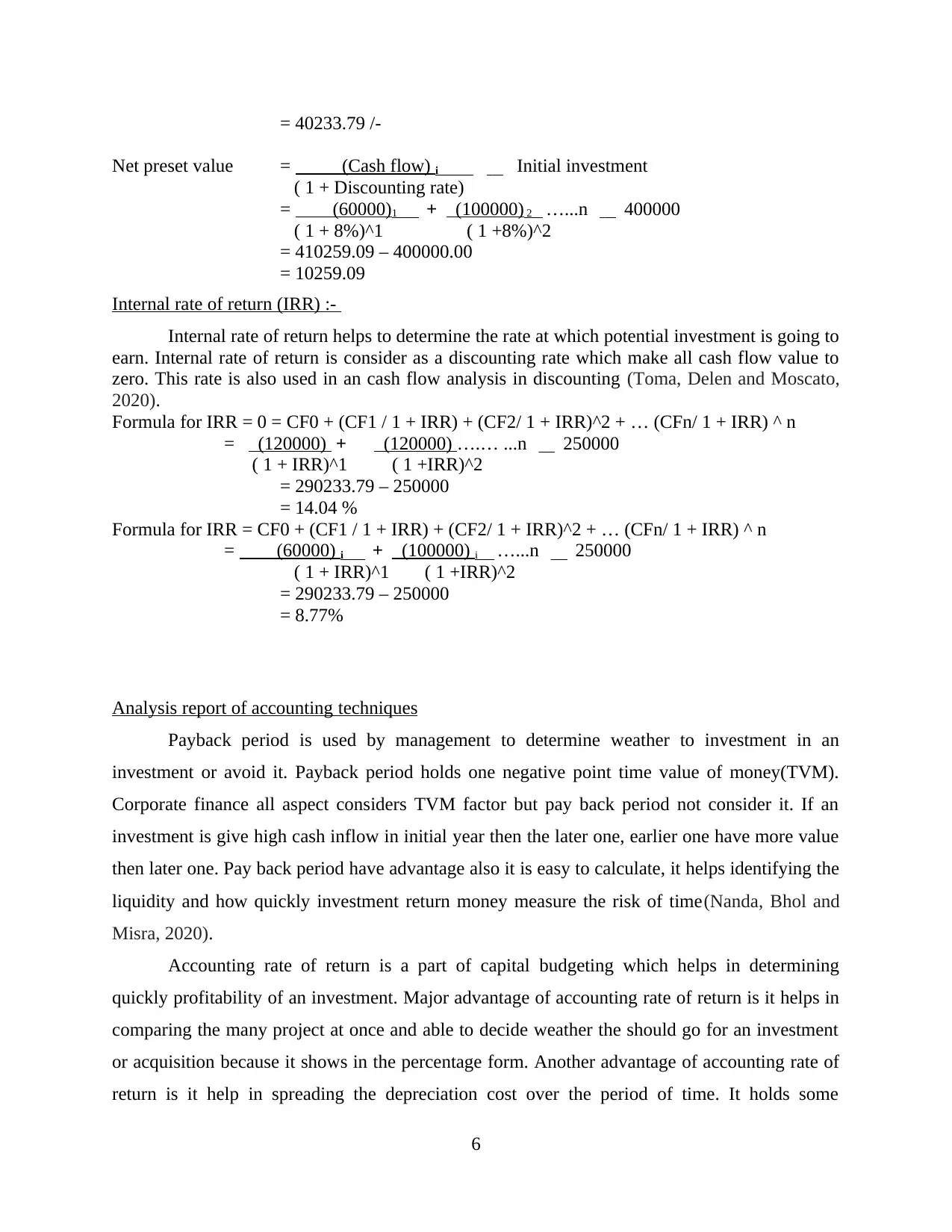
= 40233.79 /-
Net preset value = (Cash flow) i _ Initial investment
( 1 + Discounting rate)
= (60000)1 + (100000) 2 …...n _ 400000
( 1 + 8%)^1 ( 1 +8%)^2
= 410259.09 – 400000.00
= 10259.09
Internal rate of return (IRR) :-
Internal rate of return helps to determine the rate at which potential investment is going to
earn. Internal rate of return is consider as a discounting rate which make all cash flow value to
zero. This rate is also used in an cash flow analysis in discounting (Toma, Delen and Moscato,
2020).
Formula for IRR = 0 = CF0 + (CF1 / 1 + IRR) + (CF2/ 1 + IRR)^2 + … (CFn/ 1 + IRR) ^ n
= (120000) + (120000) ….… ...n _ 250000
( 1 + IRR)^1 ( 1 +IRR)^2
= 290233.79 – 250000
= 14.04 %
Formula for IRR = CF0 + (CF1 / 1 + IRR) + (CF2/ 1 + IRR)^2 + … (CFn/ 1 + IRR) ^ n
= (60000) i + (100000) i …...n _ 250000
( 1 + IRR)^1 ( 1 +IRR)^2
= 290233.79 – 250000
= 8.77%
Analysis report of accounting techniques
Payback period is used by management to determine weather to investment in an
investment or avoid it. Payback period holds one negative point time value of money(TVM).
Corporate finance all aspect considers TVM factor but pay back period not consider it. If an
investment is give high cash inflow in initial year then the later one, earlier one have more value
then later one. Pay back period have advantage also it is easy to calculate, it helps identifying the
liquidity and how quickly investment return money measure the risk of time(Nanda, Bhol and
Misra, 2020).
Accounting rate of return is a part of capital budgeting which helps in determining
quickly profitability of an investment. Major advantage of accounting rate of return is it helps in
comparing the many project at once and able to decide weather the should go for an investment
or acquisition because it shows in the percentage form. Another advantage of accounting rate of
return is it help in spreading the depreciation cost over the period of time. It holds some
6
Net preset value = (Cash flow) i _ Initial investment
( 1 + Discounting rate)
= (60000)1 + (100000) 2 …...n _ 400000
( 1 + 8%)^1 ( 1 +8%)^2
= 410259.09 – 400000.00
= 10259.09
Internal rate of return (IRR) :-
Internal rate of return helps to determine the rate at which potential investment is going to
earn. Internal rate of return is consider as a discounting rate which make all cash flow value to
zero. This rate is also used in an cash flow analysis in discounting (Toma, Delen and Moscato,
2020).
Formula for IRR = 0 = CF0 + (CF1 / 1 + IRR) + (CF2/ 1 + IRR)^2 + … (CFn/ 1 + IRR) ^ n
= (120000) + (120000) ….… ...n _ 250000
( 1 + IRR)^1 ( 1 +IRR)^2
= 290233.79 – 250000
= 14.04 %
Formula for IRR = CF0 + (CF1 / 1 + IRR) + (CF2/ 1 + IRR)^2 + … (CFn/ 1 + IRR) ^ n
= (60000) i + (100000) i …...n _ 250000
( 1 + IRR)^1 ( 1 +IRR)^2
= 290233.79 – 250000
= 8.77%
Analysis report of accounting techniques
Payback period is used by management to determine weather to investment in an
investment or avoid it. Payback period holds one negative point time value of money(TVM).
Corporate finance all aspect considers TVM factor but pay back period not consider it. If an
investment is give high cash inflow in initial year then the later one, earlier one have more value
then later one. Pay back period have advantage also it is easy to calculate, it helps identifying the
liquidity and how quickly investment return money measure the risk of time(Nanda, Bhol and
Misra, 2020).
Accounting rate of return is a part of capital budgeting which helps in determining
quickly profitability of an investment. Major advantage of accounting rate of return is it helps in
comparing the many project at once and able to decide weather the should go for an investment
or acquisition because it shows in the percentage form. Another advantage of accounting rate of
return is it help in spreading the depreciation cost over the period of time. It holds some
6
⊘ This is a preview!⊘
Do you want full access?
Subscribe today to unlock all pages.

Trusted by 1+ million students worldwide
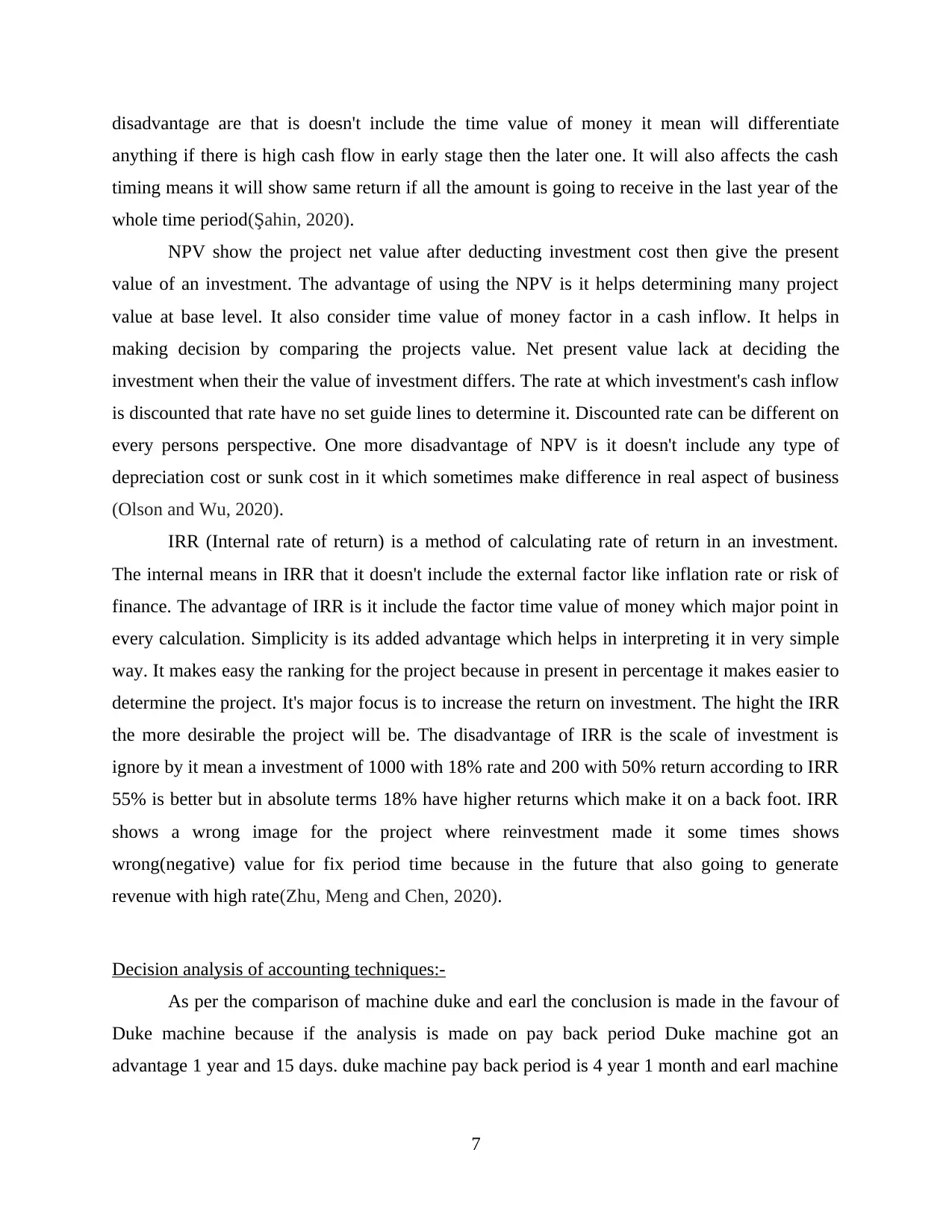
disadvantage are that is doesn't include the time value of money it mean will differentiate
anything if there is high cash flow in early stage then the later one. It will also affects the cash
timing means it will show same return if all the amount is going to receive in the last year of the
whole time period(Şahin, 2020).
NPV show the project net value after deducting investment cost then give the present
value of an investment. The advantage of using the NPV is it helps determining many project
value at base level. It also consider time value of money factor in a cash inflow. It helps in
making decision by comparing the projects value. Net present value lack at deciding the
investment when their the value of investment differs. The rate at which investment's cash inflow
is discounted that rate have no set guide lines to determine it. Discounted rate can be different on
every persons perspective. One more disadvantage of NPV is it doesn't include any type of
depreciation cost or sunk cost in it which sometimes make difference in real aspect of business
(Olson and Wu, 2020).
IRR (Internal rate of return) is a method of calculating rate of return in an investment.
The internal means in IRR that it doesn't include the external factor like inflation rate or risk of
finance. The advantage of IRR is it include the factor time value of money which major point in
every calculation. Simplicity is its added advantage which helps in interpreting it in very simple
way. It makes easy the ranking for the project because in present in percentage it makes easier to
determine the project. It's major focus is to increase the return on investment. The hight the IRR
the more desirable the project will be. The disadvantage of IRR is the scale of investment is
ignore by it mean a investment of 1000 with 18% rate and 200 with 50% return according to IRR
55% is better but in absolute terms 18% have higher returns which make it on a back foot. IRR
shows a wrong image for the project where reinvestment made it some times shows
wrong(negative) value for fix period time because in the future that also going to generate
revenue with high rate(Zhu, Meng and Chen, 2020).
Decision analysis of accounting techniques:-
As per the comparison of machine duke and earl the conclusion is made in the favour of
Duke machine because if the analysis is made on pay back period Duke machine got an
advantage 1 year and 15 days. duke machine pay back period is 4 year 1 month and earl machine
7
anything if there is high cash flow in early stage then the later one. It will also affects the cash
timing means it will show same return if all the amount is going to receive in the last year of the
whole time period(Şahin, 2020).
NPV show the project net value after deducting investment cost then give the present
value of an investment. The advantage of using the NPV is it helps determining many project
value at base level. It also consider time value of money factor in a cash inflow. It helps in
making decision by comparing the projects value. Net present value lack at deciding the
investment when their the value of investment differs. The rate at which investment's cash inflow
is discounted that rate have no set guide lines to determine it. Discounted rate can be different on
every persons perspective. One more disadvantage of NPV is it doesn't include any type of
depreciation cost or sunk cost in it which sometimes make difference in real aspect of business
(Olson and Wu, 2020).
IRR (Internal rate of return) is a method of calculating rate of return in an investment.
The internal means in IRR that it doesn't include the external factor like inflation rate or risk of
finance. The advantage of IRR is it include the factor time value of money which major point in
every calculation. Simplicity is its added advantage which helps in interpreting it in very simple
way. It makes easy the ranking for the project because in present in percentage it makes easier to
determine the project. It's major focus is to increase the return on investment. The hight the IRR
the more desirable the project will be. The disadvantage of IRR is the scale of investment is
ignore by it mean a investment of 1000 with 18% rate and 200 with 50% return according to IRR
55% is better but in absolute terms 18% have higher returns which make it on a back foot. IRR
shows a wrong image for the project where reinvestment made it some times shows
wrong(negative) value for fix period time because in the future that also going to generate
revenue with high rate(Zhu, Meng and Chen, 2020).
Decision analysis of accounting techniques:-
As per the comparison of machine duke and earl the conclusion is made in the favour of
Duke machine because if the analysis is made on pay back period Duke machine got an
advantage 1 year and 15 days. duke machine pay back period is 4 year 1 month and earl machine
7
Paraphrase This Document
Need a fresh take? Get an instant paraphrase of this document with our AI Paraphraser
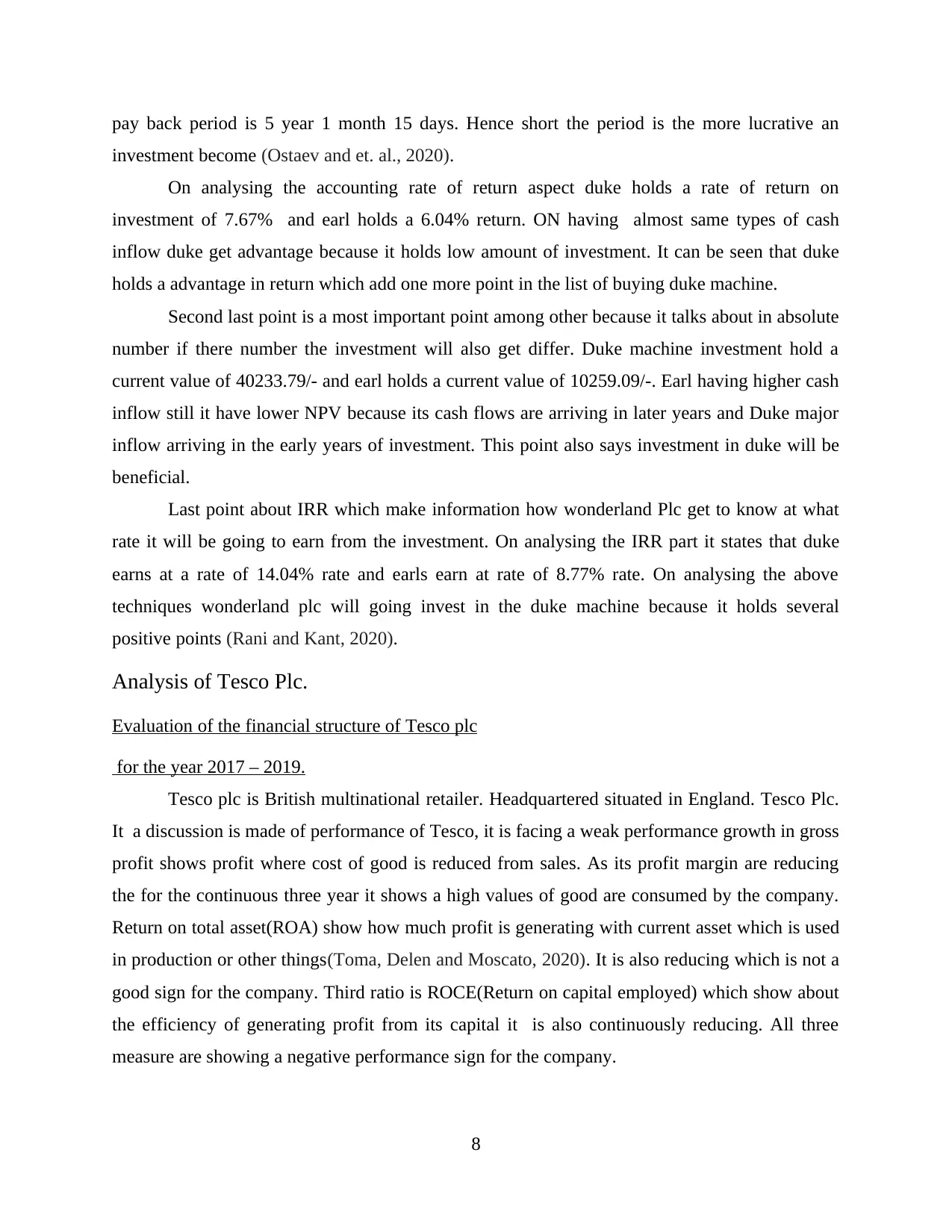
pay back period is 5 year 1 month 15 days. Hence short the period is the more lucrative an
investment become (Ostaev and et. al., 2020).
On analysing the accounting rate of return aspect duke holds a rate of return on
investment of 7.67% and earl holds a 6.04% return. ON having almost same types of cash
inflow duke get advantage because it holds low amount of investment. It can be seen that duke
holds a advantage in return which add one more point in the list of buying duke machine.
Second last point is a most important point among other because it talks about in absolute
number if there number the investment will also get differ. Duke machine investment hold a
current value of 40233.79/- and earl holds a current value of 10259.09/-. Earl having higher cash
inflow still it have lower NPV because its cash flows are arriving in later years and Duke major
inflow arriving in the early years of investment. This point also says investment in duke will be
beneficial.
Last point about IRR which make information how wonderland Plc get to know at what
rate it will be going to earn from the investment. On analysing the IRR part it states that duke
earns at a rate of 14.04% rate and earls earn at rate of 8.77% rate. On analysing the above
techniques wonderland plc will going invest in the duke machine because it holds several
positive points (Rani and Kant, 2020).
Analysis of Tesco Plc.
Evaluation of the financial structure of Tesco plc
for the year 2017 – 2019.
Tesco plc is British multinational retailer. Headquartered situated in England. Tesco Plc.
It a discussion is made of performance of Tesco, it is facing a weak performance growth in gross
profit shows profit where cost of good is reduced from sales. As its profit margin are reducing
the for the continuous three year it shows a high values of good are consumed by the company.
Return on total asset(ROA) show how much profit is generating with current asset which is used
in production or other things(Toma, Delen and Moscato, 2020). It is also reducing which is not a
good sign for the company. Third ratio is ROCE(Return on capital employed) which show about
the efficiency of generating profit from its capital it is also continuously reducing. All three
measure are showing a negative performance sign for the company.
8
investment become (Ostaev and et. al., 2020).
On analysing the accounting rate of return aspect duke holds a rate of return on
investment of 7.67% and earl holds a 6.04% return. ON having almost same types of cash
inflow duke get advantage because it holds low amount of investment. It can be seen that duke
holds a advantage in return which add one more point in the list of buying duke machine.
Second last point is a most important point among other because it talks about in absolute
number if there number the investment will also get differ. Duke machine investment hold a
current value of 40233.79/- and earl holds a current value of 10259.09/-. Earl having higher cash
inflow still it have lower NPV because its cash flows are arriving in later years and Duke major
inflow arriving in the early years of investment. This point also says investment in duke will be
beneficial.
Last point about IRR which make information how wonderland Plc get to know at what
rate it will be going to earn from the investment. On analysing the IRR part it states that duke
earns at a rate of 14.04% rate and earls earn at rate of 8.77% rate. On analysing the above
techniques wonderland plc will going invest in the duke machine because it holds several
positive points (Rani and Kant, 2020).
Analysis of Tesco Plc.
Evaluation of the financial structure of Tesco plc
for the year 2017 – 2019.
Tesco plc is British multinational retailer. Headquartered situated in England. Tesco Plc.
It a discussion is made of performance of Tesco, it is facing a weak performance growth in gross
profit shows profit where cost of good is reduced from sales. As its profit margin are reducing
the for the continuous three year it shows a high values of good are consumed by the company.
Return on total asset(ROA) show how much profit is generating with current asset which is used
in production or other things(Toma, Delen and Moscato, 2020). It is also reducing which is not a
good sign for the company. Third ratio is ROCE(Return on capital employed) which show about
the efficiency of generating profit from its capital it is also continuously reducing. All three
measure are showing a negative performance sign for the company.
8
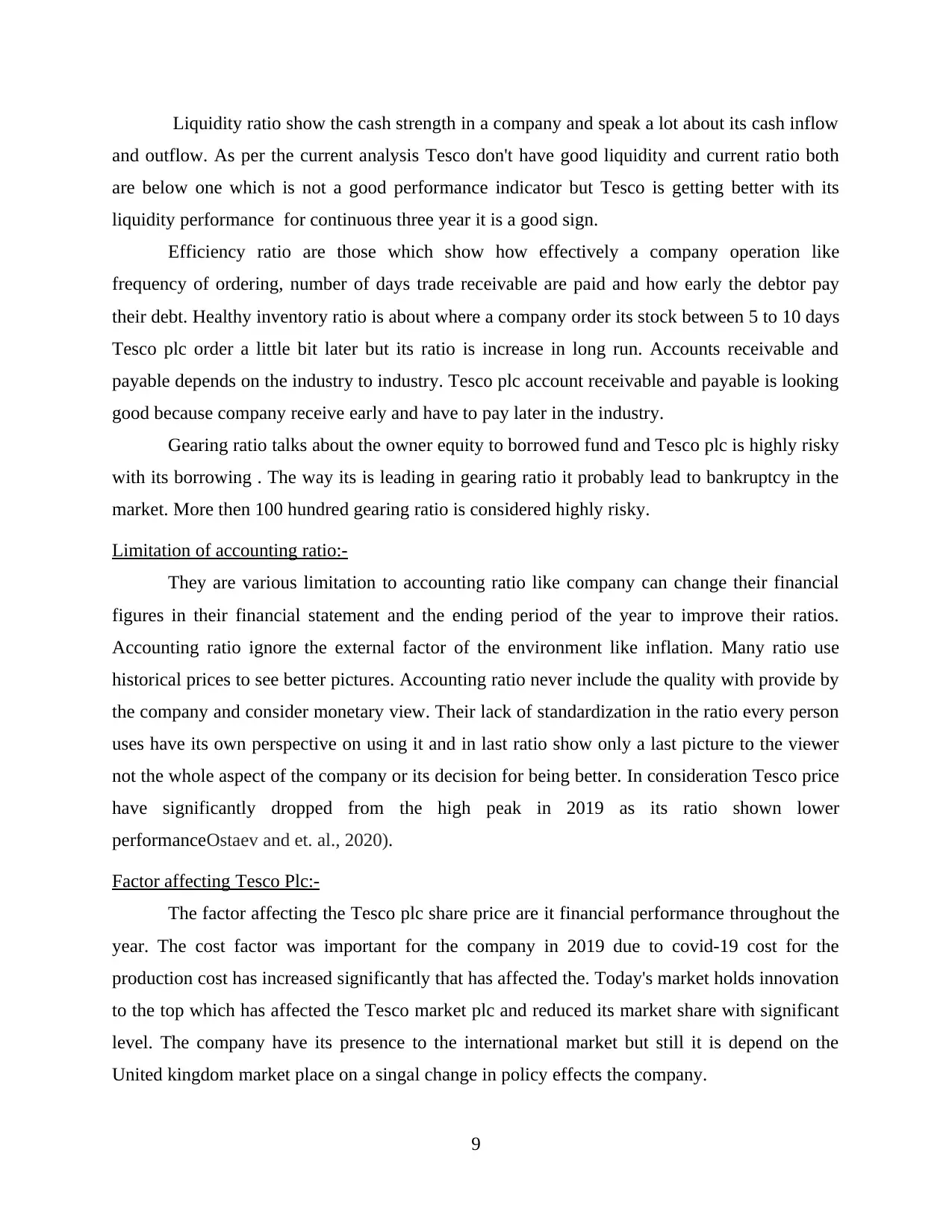
Liquidity ratio show the cash strength in a company and speak a lot about its cash inflow
and outflow. As per the current analysis Tesco don't have good liquidity and current ratio both
are below one which is not a good performance indicator but Tesco is getting better with its
liquidity performance for continuous three year it is a good sign.
Efficiency ratio are those which show how effectively a company operation like
frequency of ordering, number of days trade receivable are paid and how early the debtor pay
their debt. Healthy inventory ratio is about where a company order its stock between 5 to 10 days
Tesco plc order a little bit later but its ratio is increase in long run. Accounts receivable and
payable depends on the industry to industry. Tesco plc account receivable and payable is looking
good because company receive early and have to pay later in the industry.
Gearing ratio talks about the owner equity to borrowed fund and Tesco plc is highly risky
with its borrowing . The way its is leading in gearing ratio it probably lead to bankruptcy in the
market. More then 100 hundred gearing ratio is considered highly risky.
Limitation of accounting ratio:-
They are various limitation to accounting ratio like company can change their financial
figures in their financial statement and the ending period of the year to improve their ratios.
Accounting ratio ignore the external factor of the environment like inflation. Many ratio use
historical prices to see better pictures. Accounting ratio never include the quality with provide by
the company and consider monetary view. Their lack of standardization in the ratio every person
uses have its own perspective on using it and in last ratio show only a last picture to the viewer
not the whole aspect of the company or its decision for being better. In consideration Tesco price
have significantly dropped from the high peak in 2019 as its ratio shown lower
performanceOstaev and et. al., 2020).
Factor affecting Tesco Plc:-
The factor affecting the Tesco plc share price are it financial performance throughout the
year. The cost factor was important for the company in 2019 due to covid-19 cost for the
production cost has increased significantly that has affected the. Today's market holds innovation
to the top which has affected the Tesco market plc and reduced its market share with significant
level. The company have its presence to the international market but still it is depend on the
United kingdom market place on a singal change in policy effects the company.
9
and outflow. As per the current analysis Tesco don't have good liquidity and current ratio both
are below one which is not a good performance indicator but Tesco is getting better with its
liquidity performance for continuous three year it is a good sign.
Efficiency ratio are those which show how effectively a company operation like
frequency of ordering, number of days trade receivable are paid and how early the debtor pay
their debt. Healthy inventory ratio is about where a company order its stock between 5 to 10 days
Tesco plc order a little bit later but its ratio is increase in long run. Accounts receivable and
payable depends on the industry to industry. Tesco plc account receivable and payable is looking
good because company receive early and have to pay later in the industry.
Gearing ratio talks about the owner equity to borrowed fund and Tesco plc is highly risky
with its borrowing . The way its is leading in gearing ratio it probably lead to bankruptcy in the
market. More then 100 hundred gearing ratio is considered highly risky.
Limitation of accounting ratio:-
They are various limitation to accounting ratio like company can change their financial
figures in their financial statement and the ending period of the year to improve their ratios.
Accounting ratio ignore the external factor of the environment like inflation. Many ratio use
historical prices to see better pictures. Accounting ratio never include the quality with provide by
the company and consider monetary view. Their lack of standardization in the ratio every person
uses have its own perspective on using it and in last ratio show only a last picture to the viewer
not the whole aspect of the company or its decision for being better. In consideration Tesco price
have significantly dropped from the high peak in 2019 as its ratio shown lower
performanceOstaev and et. al., 2020).
Factor affecting Tesco Plc:-
The factor affecting the Tesco plc share price are it financial performance throughout the
year. The cost factor was important for the company in 2019 due to covid-19 cost for the
production cost has increased significantly that has affected the. Today's market holds innovation
to the top which has affected the Tesco market plc and reduced its market share with significant
level. The company have its presence to the international market but still it is depend on the
United kingdom market place on a singal change in policy effects the company.
9
⊘ This is a preview!⊘
Do you want full access?
Subscribe today to unlock all pages.

Trusted by 1+ million students worldwide
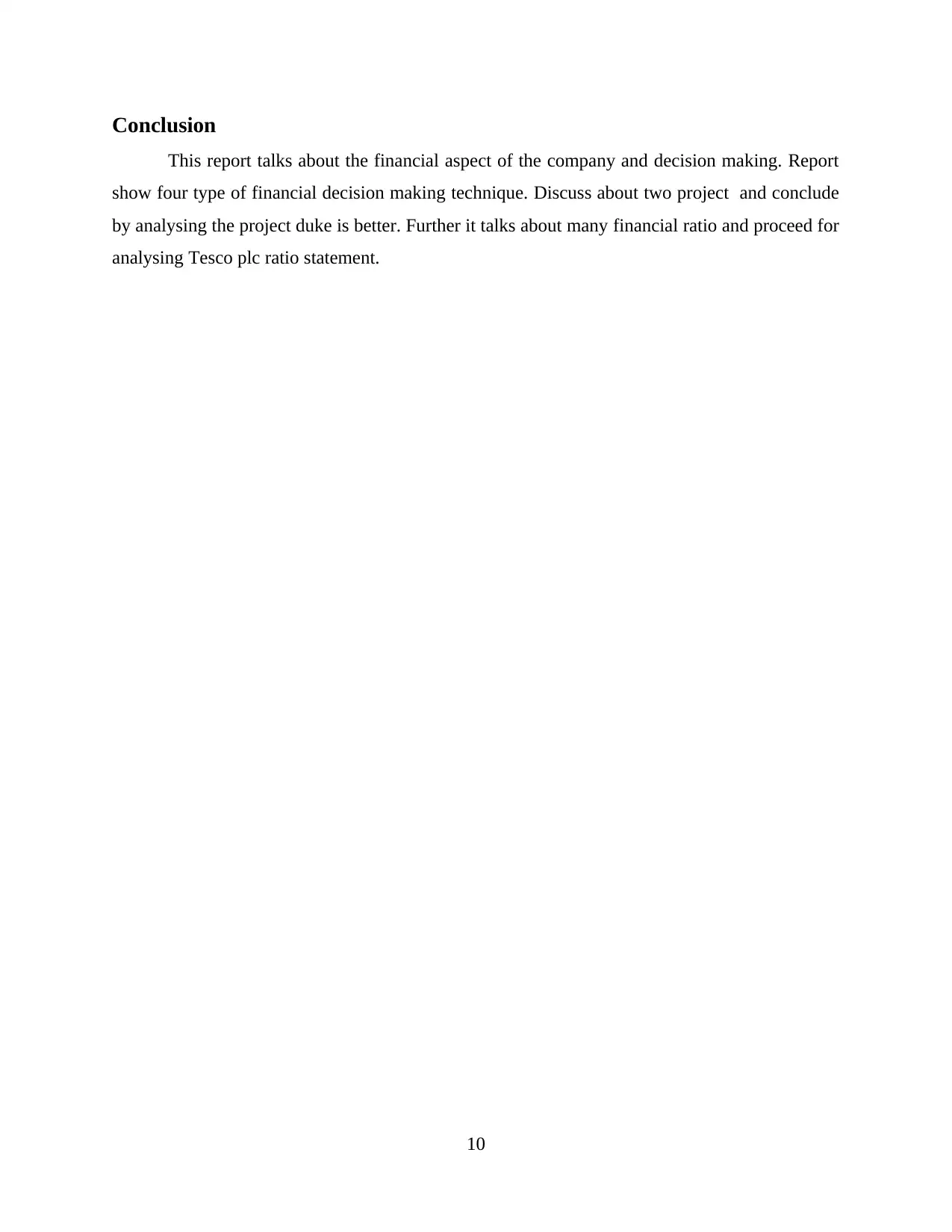
Conclusion
This report talks about the financial aspect of the company and decision making. Report
show four type of financial decision making technique. Discuss about two project and conclude
by analysing the project duke is better. Further it talks about many financial ratio and proceed for
analysing Tesco plc ratio statement.
10
This report talks about the financial aspect of the company and decision making. Report
show four type of financial decision making technique. Discuss about two project and conclude
by analysing the project duke is better. Further it talks about many financial ratio and proceed for
analysing Tesco plc ratio statement.
10
Paraphrase This Document
Need a fresh take? Get an instant paraphrase of this document with our AI Paraphraser
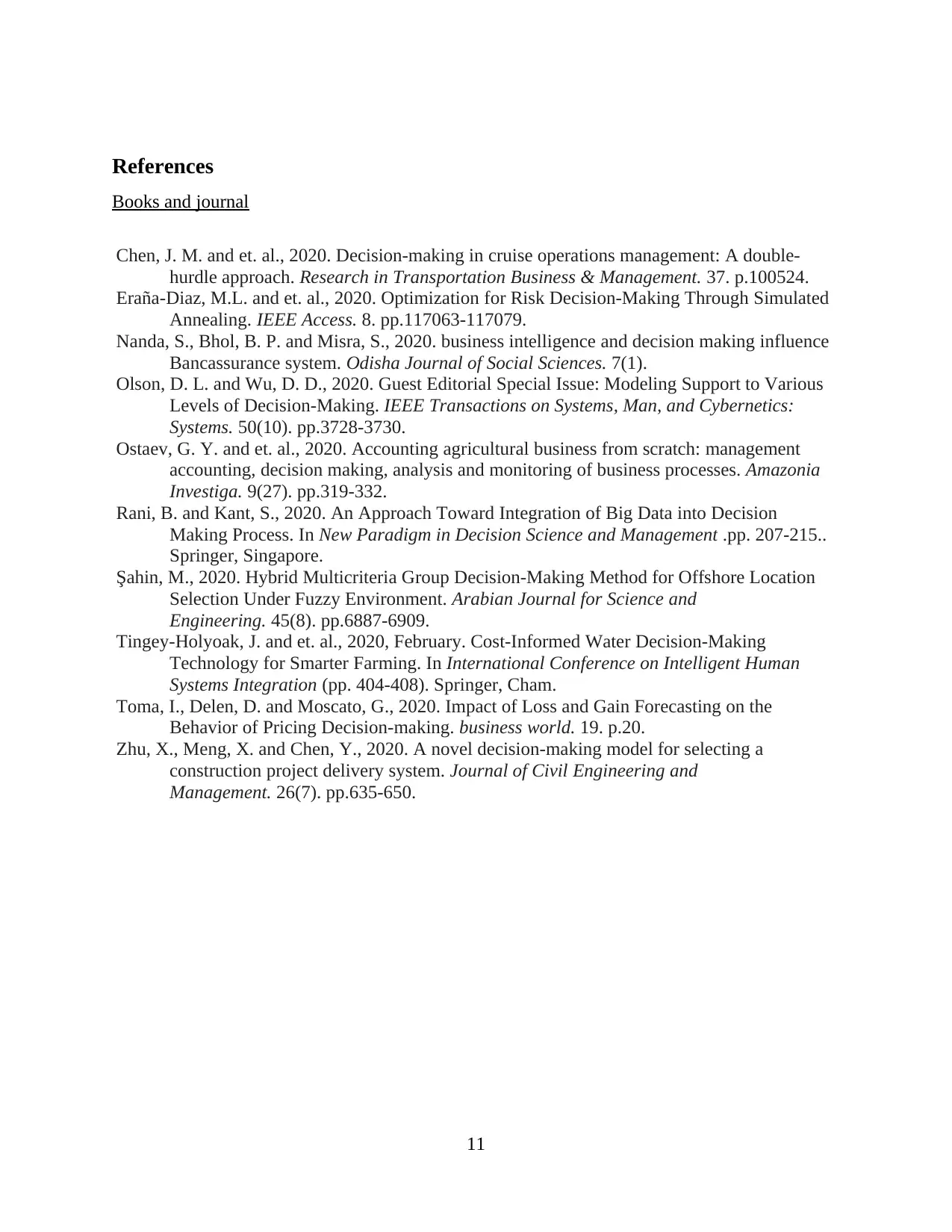
References
Books and journal
Chen, J. M. and et. al., 2020. Decision-making in cruise operations management: A double-
hurdle approach. Research in Transportation Business & Management. 37. p.100524.
Eraña-Diaz, M.L. and et. al., 2020. Optimization for Risk Decision-Making Through Simulated
Annealing. IEEE Access. 8. pp.117063-117079.
Nanda, S., Bhol, B. P. and Misra, S., 2020. business intelligence and decision making influence
Bancassurance system. Odisha Journal of Social Sciences. 7(1).
Olson, D. L. and Wu, D. D., 2020. Guest Editorial Special Issue: Modeling Support to Various
Levels of Decision-Making. IEEE Transactions on Systems, Man, and Cybernetics:
Systems. 50(10). pp.3728-3730.
Ostaev, G. Y. and et. al., 2020. Accounting agricultural business from scratch: management
accounting, decision making, analysis and monitoring of business processes. Amazonia
Investiga. 9(27). pp.319-332.
Rani, B. and Kant, S., 2020. An Approach Toward Integration of Big Data into Decision
Making Process. In New Paradigm in Decision Science and Management .pp. 207-215..
Springer, Singapore.
Şahin, M., 2020. Hybrid Multicriteria Group Decision-Making Method for Offshore Location
Selection Under Fuzzy Environment. Arabian Journal for Science and
Engineering. 45(8). pp.6887-6909.
Tingey-Holyoak, J. and et. al., 2020, February. Cost-Informed Water Decision-Making
Technology for Smarter Farming. In International Conference on Intelligent Human
Systems Integration (pp. 404-408). Springer, Cham.
Toma, I., Delen, D. and Moscato, G., 2020. Impact of Loss and Gain Forecasting on the
Behavior of Pricing Decision-making. business world. 19. p.20.
Zhu, X., Meng, X. and Chen, Y., 2020. A novel decision-making model for selecting a
construction project delivery system. Journal of Civil Engineering and
Management. 26(7). pp.635-650.
11
Books and journal
Chen, J. M. and et. al., 2020. Decision-making in cruise operations management: A double-
hurdle approach. Research in Transportation Business & Management. 37. p.100524.
Eraña-Diaz, M.L. and et. al., 2020. Optimization for Risk Decision-Making Through Simulated
Annealing. IEEE Access. 8. pp.117063-117079.
Nanda, S., Bhol, B. P. and Misra, S., 2020. business intelligence and decision making influence
Bancassurance system. Odisha Journal of Social Sciences. 7(1).
Olson, D. L. and Wu, D. D., 2020. Guest Editorial Special Issue: Modeling Support to Various
Levels of Decision-Making. IEEE Transactions on Systems, Man, and Cybernetics:
Systems. 50(10). pp.3728-3730.
Ostaev, G. Y. and et. al., 2020. Accounting agricultural business from scratch: management
accounting, decision making, analysis and monitoring of business processes. Amazonia
Investiga. 9(27). pp.319-332.
Rani, B. and Kant, S., 2020. An Approach Toward Integration of Big Data into Decision
Making Process. In New Paradigm in Decision Science and Management .pp. 207-215..
Springer, Singapore.
Şahin, M., 2020. Hybrid Multicriteria Group Decision-Making Method for Offshore Location
Selection Under Fuzzy Environment. Arabian Journal for Science and
Engineering. 45(8). pp.6887-6909.
Tingey-Holyoak, J. and et. al., 2020, February. Cost-Informed Water Decision-Making
Technology for Smarter Farming. In International Conference on Intelligent Human
Systems Integration (pp. 404-408). Springer, Cham.
Toma, I., Delen, D. and Moscato, G., 2020. Impact of Loss and Gain Forecasting on the
Behavior of Pricing Decision-making. business world. 19. p.20.
Zhu, X., Meng, X. and Chen, Y., 2020. A novel decision-making model for selecting a
construction project delivery system. Journal of Civil Engineering and
Management. 26(7). pp.635-650.
11
1 out of 11
Related Documents
Your All-in-One AI-Powered Toolkit for Academic Success.
+13062052269
info@desklib.com
Available 24*7 on WhatsApp / Email
![[object Object]](/_next/static/media/star-bottom.7253800d.svg)
Unlock your academic potential
© 2024 | Zucol Services PVT LTD | All rights reserved.





